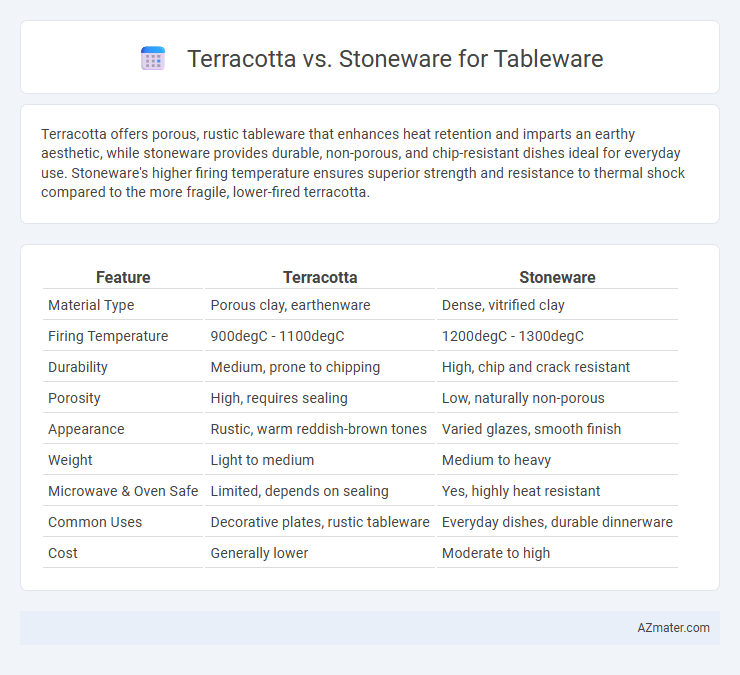Terracotta offers porous, rustic tableware that enhances heat retention and imparts an earthy aesthetic, while stoneware provides durable, non-porous, and chip-resistant dishes ideal for everyday use. Stoneware's higher firing temperature ensures superior strength and resistance to thermal shock compared to the more fragile, lower-fired terracotta.
Table of Comparison
| Feature | Terracotta | Stoneware |
|---|---|---|
| Material Type | Porous clay, earthenware | Dense, vitrified clay |
| Firing Temperature | 900degC - 1100degC | 1200degC - 1300degC |
| Durability | Medium, prone to chipping | High, chip and crack resistant |
| Porosity | High, requires sealing | Low, naturally non-porous |
| Appearance | Rustic, warm reddish-brown tones | Varied glazes, smooth finish |
| Weight | Light to medium | Medium to heavy |
| Microwave & Oven Safe | Limited, depends on sealing | Yes, highly heat resistant |
| Common Uses | Decorative plates, rustic tableware | Everyday dishes, durable dinnerware |
| Cost | Generally lower | Moderate to high |
Introduction to Terracotta and Stoneware
Terracotta and stoneware are popular ceramic materials used for tableware, each with distinct properties and aesthetics. Terracotta is a porous, reddish clay fired at lower temperatures, known for its rustic, earthy appearance and heat retention qualities. Stoneware is denser, non-porous, and fired at higher temperatures, offering greater durability, chip resistance, and a wide range of glaze finishes suitable for everyday use.
Material Composition and Characteristics
Terracotta tableware is made from porous, low-fired clay with a high iron content that gives it a reddish-brown color, offering a rustic and breathable quality but requiring careful sealing to prevent moisture absorption. Stoneware tableware, crafted from dense, high-fired clay containing silica, feldspar, and kaolin, is non-porous, durable, and resistant to chipping and thermal shock, making it ideal for everyday use. The vitrification process in stoneware creates a harder surface compared to terracotta, resulting in enhanced strength and water resistance.
Manufacturing Processes Compared
Terracotta tableware is made from porous, low-firing clay that is shaped and air-dried before being kiln-fired at temperatures between 1000degC and 1150degC, resulting in a softer, more absorbent material. Stoneware undergoes a high-temperature firing process, typically between 1200degC and 1300degC, using dense, non-porous clay that vitrifies during firing, producing durable, chip-resistant, and non-porous tableware. The manufacturing process differences affect the final product's strength, porosity, and suitability for different uses like microwaving or dishwasher safety.
Durability and Strength Differences
Terracotta tableware is porous and more prone to chipping and cracking due to its relatively low firing temperature, making it less durable compared to stoneware. Stoneware is fired at higher temperatures around 1200-1300degC, resulting in a dense, non-porous material that offers superior strength and resistance to everyday wear. The enhanced durability of stoneware makes it ideal for frequent use and dishwasher safety, whereas terracotta requires gentler handling to maintain longevity.
Aesthetic Qualities and Visual Appeal
Terracotta tableware offers a warm, rustic aesthetic with its natural reddish-brown hues and slightly porous texture that enhances artisanal charm. Stoneware presents a more refined visual appeal through its smooth, often glazed surface, available in a wide range of colors and finishes that suit both modern and traditional settings. The choice between terracotta and stoneware hinges on desired ambiance, with terracotta evoking earthy authenticity and stoneware delivering sleek durability.
Heat Resistance and Microwave Safety
Terracotta tableware offers moderate heat resistance but can crack under sudden temperature changes, making it less ideal for microwave use. Stoneware exhibits superior heat resistance, tolerating higher temperatures and rapid heating without damage, ensuring better microwave safety. Choosing stoneware enhances durability and convenience for everyday microwave and oven use.
Maintenance and Cleaning Ease
Terracotta tableware requires gentle hand washing and occasional sealing to prevent moisture absorption and staining due to its porous nature. Stoneware, being denser and less porous, offers greater resistance to chipping and is dishwasher safe, making it easier to maintain and clean. Both materials benefit from mild detergents, but stoneware's durability and non-porous surface make it more convenient for everyday use.
Price and Accessibility
Terracotta tableware is generally more affordable and widely accessible due to its abundant natural clay resources and simpler production processes. Stoneware tends to be pricier because of its durability, higher firing temperatures, and more refined manufacturing techniques, often limiting availability to specialty retailers. Consumers seeking budget-friendly, rustic options often prefer terracotta, while those valuing long-lasting, chip-resistant tableware may invest in stoneware despite the higher cost.
Best Uses in Everyday Tableware
Terracotta tableware is ideal for serving rustic, casual meals due to its porous nature and earthy aesthetic, which retains heat well but requires careful handwashing to prevent cracking. Stoneware offers greater durability and chip resistance, making it more suitable for everyday use, including microwave and dishwasher safety. Both materials provide excellent versatility, but stoneware's robustness and ease of maintenance make it the preferred choice for busy kitchens and frequent dining.
Choosing the Right Material for Your Table
Terracotta tableware offers natural porosity and a rustic aesthetic but requires sealing to prevent moisture absorption and staining, making it ideal for dry or decorative use. Stoneware provides superior durability, chip resistance, and non-porous surfaces, making it a practical choice for everyday dining and dishwasher-safe versatility. Selecting stoneware ensures long-lasting performance and ease of maintenance, while terracotta suits artisanal settings where visual appeal is prioritized over durability.

Infographic: Terracotta vs Stoneware for Tableware
 azmater.com
azmater.com